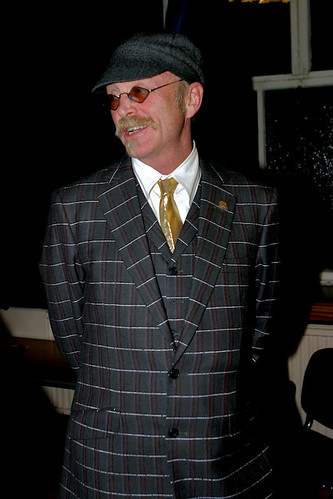fet•ish |ˈfeti sh |
noun
•an inanimate object worshiped for its supposed magical powers or because it is considered to be inhabited by a spirit.
Now, bear that definition in mind as you read

and view
this article from the Style (of course!) section of the New York Times, a photo layout of high-fashion models draped over Dutch and high-end American street bicycles. After reading (with no small amount of amusement) this article, I have come to the inescapable conclusion that bicycles are now a fetish in urban America. Since it is defined as bestowing powers, what can we say is the power it might bestow? I submit that the power (in today's America) is
coolness.
Bikes have become cool. Partly as a result of Lance, partly as a result of the skinny young bike couriers, partly as a result of the ecological movement, partly as a result of last year's gasoline price bubble, bicycles have
arrived.
The fashion models bear witness to this. I mean, really! The set of individuals who would not only bike to work but who would insist on being a fashion plate is very, very small. This is not for societal reasons, it's for practical ones. Let's examine a quote from the Times article:
Can the bicycle, the urban answer to the wild mustang, slow down and put fenders on? Can the urban cyclist, he of the ragtag renegade clothes or shiny spandex, grow up and put on a tie?
I think what's interesting is the way this quote (and the article as a whole) presents this as an
either-or. Either spandex or worsted. Either wild or staid. Either adolescent or grown-up. While the either-or is effective as a literary device, I think it's a bit overwrought in this particular case. Let's look at some facts:
"Real" cycle-commuters have to deal with the weather. Even sitting upright on a Dutch bike, in New York City there are probably only about six weeks out of the year (three in spring, three in fall) where you could ride to work a distance of greater than 3 miles and not get either grossly lathered up or pretty darn cold. Fashion cycling is a very limited activity, and people who cycle because they are motivated by fashion-good-looks won't be doing so for very much of the year.
"Real" cycle-commuters have to deal with safety. The Times article states, "Dutch bikes are ridden upright, not hunched over, and you move at a safe, slow gait". Please! Moving at a "slow gait" on the streets of Manhattan is safe? Riding a bike to work, preoccupied with how I'm going to keep my
two-thousand dollar Marc Jacobs suit from getting stained or ripped is safe? Not wearing a helmet because "..riding a bike should be normal, and you shouldn’t have to wear a funny Styrofoam hat” is safe?
"Real" cycle-commuters in the City have to deal with New York. The article pays lip service to the ever-present everyday problems of the commuter: the traffic, the fear of theft, the lack of secure bike parking. None of these are made any easier by being dressed fashionably. (Lugging and lifting bikes is a great way to rip tight-fitting pretty-boy suits. I think the look on the face of the model in
this picture, dealing with the folding bike, says it all.)
The Times article, in the end, is kind of a mish-mash (or "mashup," the more popular contemporary term). It flits around, and touches on a wide variety of very valid and interesting issues, but doesn't stay with any of them long

enough to make sense. Of course, that's not its point. Its point is to sell fashion, which it does admirably with its
slide show.
This isn't the first recent intersection of bicycling and fashion that comes to mind. There are the
$3000 cycling suits by Rapha, fresh from Savile Row, and the
seriously sartorial
Dashing Tweeds get-up that bike manufacturer Gary Fisher (right) recently was fitted for in London. The Dashing Tweeds suit is made of Lumatwill, a fabric whose pinstripes are reflective for night riding. Like Gore-tex it's a Teflon laminated fabric, so it's both breathable and waterproof. To me, this is a
true bespoke ("custom" for those of you who don't speak the King's English) suit for a cyclist. It's truly forward-looking and (assuming as I must that it's cut for freedom of movement) represents something that could be seriously used by a commuter on those days when he just
has to wear a suit.
David Colman of the Times has put up a visually interesting article, but ultimately it's about the conventional fashion trade. It seems ironic to me that there's a true story going on about cycling and cycle-clothing, however, and they're missing it.
PS: Hey, NYTimes, where are the female models? Is it just too hard to reconcile the way that real female cyclists look with the current uber-anorexic female fashion model?
 The city of Austin, Texas (my old burg) has decided to right the wrongs of the
The city of Austin, Texas (my old burg) has decided to right the wrongs of the 


























